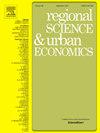Health facility quality peer effects: Are financial incentives necessary?
IF 2.9
2区 经济学
Q1 ECONOMICS
引用次数: 0
Abstract
This paper examines peer effects in health facility quality in South Africa. Specifically, we investigate whether health facilities adapt their quality in response to changes in the quality of peer facilities, even in the absence of material incentives for doing so. Using a national census of public primary health facilities, we exploit data on structural and process components of quality, examining how these measures change from 2015 to 2017. We examine facilities strategic interactions using both a spatial econometrics approach and a more traditional quasi-experimental approach exploiting a quality improvement program as a source of exogeneous variation to estimate the response of facilities to changes in the quality of their peers. We find evidence of quality peer effects between primary health care facilities, with a 10-unit increase in average District facility quality causing facilities to increase their quality by 3.6 units. Given the lack of financial incentives, we propose prosocial motivation and reputational concerns as the mechanism inducing facilities to respond to changes in peer quality. This finding is consistent with recent literature which has stressed the role measurement and public reporting can play in improving public service, and particularly health care, provision. Importantly, our findings have significant policy implications suggesting the provision of relative performance information, allowing for peer comparisons, can induce a form of quality yardstick competition and be a credible quality improvement policy which may be considered alongside health financing reforms.
卫生设施质量同伴效应:是否需要财政激励?
本文考察了南非卫生设施质量中的同伴效应。具体而言,我们调查卫生机构是否调整其质量以应对同行设施质量的变化,即使在没有物质激励的情况下这样做。通过对公共初级卫生设施的全国普查,我们利用了质量的结构和过程组成部分的数据,研究了这些措施在2015年至2017年之间的变化。我们使用空间计量经济学方法和更传统的准实验方法来研究设施的战略相互作用,利用质量改进计划作为异质变化的来源来估计设施对其同行质量变化的反应。我们发现初级卫生保健设施之间存在质量对等效应的证据,平均地区设施质量提高10个单位,导致设施质量提高3.6个单位。在缺乏经济激励的情况下,我们提出了亲社会动机和声誉关注作为诱导设施响应同伴质量变化的机制。这一发现与最近强调测量和公开报告在改善公共服务,特别是卫生保健提供方面可以发挥作用的文献是一致的。重要的是,我们的研究结果具有重要的政策意义,表明提供相对绩效信息,允许同行比较,可以诱导一种形式的质量标准竞争,并且是一种可信的质量改进政策,可以与卫生融资改革一起考虑。
本文章由计算机程序翻译,如有差异,请以英文原文为准。
求助全文
约1分钟内获得全文
求助全文
来源期刊

Regional Science and Urban Economics
Multiple-
CiteScore
5.30
自引率
9.70%
发文量
63
期刊介绍:
Regional Science and Urban Economics facilitates and encourages high-quality scholarship on important issues in regional and urban economics. It publishes significant contributions that are theoretical or empirical, positive or normative. It solicits original papers with a spatial dimension that can be of interest to economists. Empirical papers studying causal mechanisms are expected to propose a convincing identification strategy.
 求助内容:
求助内容: 应助结果提醒方式:
应助结果提醒方式:


